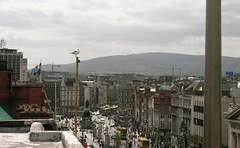Ingredients:
75g best quality fresh tuna (or salmon)
handful of chives
4 asparagus spears, steamed
teaspoon of salt
two tablespoons of sugar
1/3 cup rice vinegar
2 cups sushi rice
4 sheets nori (19×21 cm approx)
Rinse the sushi rice under a running tap till the water runs clear, then drain it, put it in a pot and cover with about two-and-a-half cups of water. Bring it to the boil covered and reduce the heat to a very gentle simmer. Cook for about 20 minutes and then let it sit for about another 15. Dissolve the vinegar, sugar and salt over a low heat and allow to cool.
When the rice is cooked, sprinkle the vinegar mixture over it and gently stir it in, being careful not to mash up the grains of rice. If you’re a real sushi aficionado, you’ll want to fan the rice to cool it. I’m not and I didn’t. The sushi gods will probably frown on me for evermore.
Anyway, place the nori on a board. Thinly spread a layer of rice over about the nearest 80 percent of the sheet. Then place a spear of asparagus across it about a third of the way down (i.e. near you), similarly some chives and then the fish of your choice. Gently roll the nori and contents, not over-vigorously, and when you’re almost there, seal the roll with a wiping of water along the far edge. Then with a very sharp knife, cut the roll into bite-sized pieces. It helps to wet the knife under a tap first. The amount of rice you put in is up to you, it’ll obviously afect the girth of the roll. Better to experiment – thinner is probably better than fatter to start with. If you’re really adventurous, you could try rolling it into a cone instead.
Makes four rolls – feeds four or five.


THE VERDICT
The flavour was good. I was pleased with the outcome despite the amateurish presentation, and both daughter and wife enojoyed the eating of them, although the wife isn’t really a sushi fan. I’d prepared a version with ham instead of fish to satisfy the non-fish-eaters which is probably punishable by death in Japan, but the daughter really enjoyed them. She also enojoyed the tuna version, much to my surprise. She wouldn’t take the wasabi, however much I tried to tempt her. Nor the pickled ginger. I love it, of course.
This was my second attempt at making sushi, the first being many years ago when I was a lad (and it was a disaster). I should have a rolling mat but I just made do with fingers. Next time I’ll work on the presentation and attempt more beautiful rollings with a better dispersal of ingredients. As you can see above, the filling is all in a lump – I’d prefer if it was distributed a little more. I’ll also experiment with fillings, possibly some vegetables to feed the vegetarianistas. Nothing with a face…







